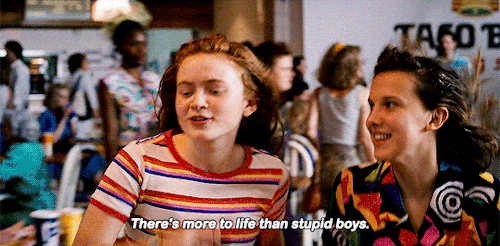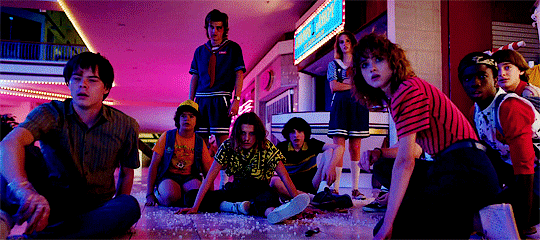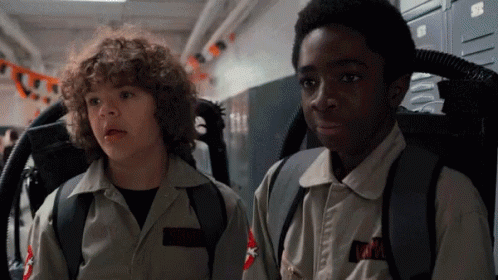WARNING: Spoilers for major plot points from seasons 1, 2, and 3 of Stranger Things ahead!
Ah, Stranger Things. The mega-popular Netflix show that made you wonder, Am I wasting my childhood? Why don’t I have such a tight-knit group of friends? Should I learn how to ride my bike better? How come there are no supernatural threats to save my town from? (I feel like I’m not the only teen to have thought this. Am I the only teen to have thought this?)
Well, it’s back now, and in my opinion, it’s better than ever!
This may be a bit surprising to hear, given that there’ve been so many leaning-towards-negative reviews (though there have been some glowing ones too, from the Atlantic and the Guardian, among other sites). That was pretty surprising to me, since I thought season 3 was a vast improvement from season 2–and even the critically acclaimed season 1.
I won’t pretend to be a mega-fan of Stranger Things–I am definitely a more casual viewer –but I do like writing about media and anyway after that finale my feelings are an exposed live wire, so I’m going to break down what I thought made it so good because catharsis!
One thing I didn’t like about Stranger Things from the get-go was the tired old trope of there only being one girl in an otherwise all-male group (known as “The Smurfette Principle”). In season 1, Eleven was exactly that–the odd one out of The Party, not just because of her powers, but also because of her gender. They did that thing where the boys act like they just don’t know what to do in her presence because…you know. They’re nerds and they’ve never interacted with one before, isn’t that so original haha! (They also had a brief, quasi-Born Sexy Yesterday moment made all the more uncomfortable by the fact that El is, like, twelve in that season.)
Plus, El has a pretty upsetting backstory, and I feel like they missed a real opportunity to explore trauma in a girl who doesn’t have all the words to express it, instead opting to use Will’s experiences and its effects on his family and friends as the driving emotional force of the second season. Not that that’s not interesting, but I feel like we’ve been there, done that. I would really love to see a nuanced exploration of female trauma, particularly trauma in girls, given that so many of us face it at such an early age. There’s a real opportunity there, not just for a great story with a lot of pathos, but also for truly groundbreaking television that speaks to the current moment. That, to me, is a lot more compelling than Will Byers getting goosebumps and shaking for half of season 2. Despite literally being raised! as! a! lab! rat! for! the! U.S.! government!, we still don’t see much of a healing process for El in any of the seasons, including season 3, which I’m a little bitter about. (And no, that whole season 2 El-in-Chicago thing was not enough. It was a hot mess.)
Speaking of season 2, the writers seemed to realize that there was a real hunger for more female characters after fan-favorite Barb was killed off. So they brought in Max Mayfield, and…it was frustrating, to say the least. You knew she was cool because she liked video games and she skateboarded and she demeaned other characters for screaming “like a little girl.” In other words, she was coded like a male character, and therefore she was good enough for the all-male Party (because at this point El’s MIA after season 1’s finale). If the Duffer brothers thought they could hide Max’s weak characterization behind the label of “tomboy” and write it off as some sort of girl-power thing…well, it didn’t sit well with a lot of viewers, including me. (Not that I don’t love the actress, Sadie Sink, and think that she was doing the best she could with what she was given.)
More criticism surfaced after El and Max became antagonistic toward each other after it appeared, very briefly, that Max might take the place of El as Mike’s love interest. Cue the groans of audiences tired of girls being pitted against girls, especially over a boy, especially by male writers. (Can we please, please get rid of this trope? I hate it and I’m ready for the girls supporting girls 2k19 revolution, baby.)
To be fair, tropes aren’t just ornamentation in Stranger Things, and they’re not lazily deployed. They’re meant to be noticed–whether to shorthand meaning or to subvert it. And the show is at its best when it subverts: The grizzled, drunken cop turning into a father figure trying his hardest to raise a teenager, the high school girl all starry-eyed over a jerk of a boy before realizing that there are more important things (like saving her friends from monsters), that jerk of a boy becoming a hero in his own right–the list goes on. The fact that El and Max weren’t given that same depth and complexity speaks less to an homage of 80s pop culture and more to our still-outdated ideas of what teen girls are supposed to act like–catty, jealous, bitchy. (Here’s a really great article that explains this a little more clearly.)
And then came season 3!
Let’s discuss how El and Max changed first. It seems that the writers really took this criticism, widely echoed among fans and reviewers alike, to heart. The two of them have become BFFs in the year since we left off. They have sleepovers and go to the mall for a very enjoyable makeover montage. Max educates El in the ways of teenage romance, culminating in a funny scene where El “dumps [Mike’s] ass.”

It’s not all fun and games, though. They’re the first of the group to investigate the prospect that something fishy’s going on with Max’s stepbrother Billy when a lifeguard at the pool he works at goes missing, kickstarting the action. They’re not bystanders or sidekicks this season, not used as a foil for the male characters or as a weapon to overcome any obstacles in their way. They’re given real autonomy, and that’s quite a departure from how they’ve been characterized before.
Although Max and El’s friendship isn’t explored as deeply as the bond between Mike, Will, Dustin, and Lucas in the first two seasons, I’m hopeful that we’ll continue to see the connection between Max and El deepen. (Honestly, writers, there is so much there–I’m constantly shocked by shows that don’t utilize the absolute incredible depth and nuance of young female friendships. SO UTILIZE IT!)
Plus, there’s a really great scene where Max defends El’s competence and autonomy to decide for herself how she uses her powers, even if it might be dangerous.
“Who do you think should decide El’s limits?” Max asks angrily as Mike frets about whether El will get brain damage using her powers. “Mike or Eleven?”
“The way you frame that is such bullshit,” Mike shoots back.
“It’s not bullshit, Mike. This is your whole problem. And it’s also precisely the reason why she dumped your ass…The fact is, she’s not yours. She’s her own person, fully capable of making her own decisions.”
A little on-the-nose? Maybe, but it makes a very valid point about how, you know, El’s saved the world twice already and she’s still infantilized by the people around her.
In regard to Eleven specifically, she feels much less like a blank slate. Millie Bobby Brown’s performance is so much more alive this season–she thrives on rage, desperation, sorrow, love. She has a lot more to work with. It’s a far cry from her two emotions back in season 1: confused and angry. She’s absolutely electrifying in the heat of battle and in the throes of grief alike.
Max as a character has also evolved. Skateboarding isn’t her only pursuit anymore. She’s reconciling the terror of a stepbrother she knew with the possibility that he might not make it out of this mess alive; she’s finding her place within The Party; she’s forming bonds with El and her boyfriend Lucas. It’s absolutely wonderful to watch.
Season 3 also introduces a new character–Robin, Steve’s co-worker at Scoops Ahoy, the ice cream shop in the mall food court. She’s witty, dry, and smart, translating a secret code with the help of Steve and Dustin that starts them on an adventure to take down a sect of Russians in Hawkins determined to open the gate to the Upside Down.
There are a lot of characters to keep track of this season, and not a lot of screen time to split between all of them, but Robin still gets her time in the spotlight.
Spoiler: It’s magnificent.
Y’all. She’s so good. Just so good. Her character plays so well off of Steve’s, and her scenes are some of my favorites out of the entire series. Plus, Maya Hawke (21) looks way more like a teenager than 27-year-old Joe Keery, so that helps. Her storyline was the one I was most invested in, even though it’s secondary to the Mind Flayer A-plot, and the writers putting The Scoops Troop together (consisting of Robin, Steve, Dustin, and the hilarious Erica) was a fantastic choice.
Plus, they let Robin simply exist, untethered from male characters in the way that El, Max, and Nancy are. She’s her own person from the get-go, not having to wait a few seasons to have her own character traits that aren’t inextricably tied to her experiences with the boys around her.
I was expecting, though, that Steve and Robin would couple off–that’s the way things seemed to be heading, even if I thought that was a terrible choice. But I was pleasantly surprised by a quietly profound scene in the second-to-last episode.
Robin, as it turns out, is gay, and definitely not in love with Steve, even if Steve is a little in love with her. Instead of shunning her, Steve accepts her, cracks a few jokes, and gets on with fighting monsters. Wishful thinking for the ’80s? Probably, but it fit well with both Robin’s and Steve’s character arcs, and, I will admit, I did cry. Just a little. It’s the emotional heft the Scoops Troop subplot needed right as the humor that had been sustaining it was starting to run dry.
All that being said, there are still some things to be improved upon with regard to Stranger Things’ female characters. It’s great that Nancy gets a bigger role this season, but when will she be able to grow beyond Jonathan? Why did Joyce, one of the show’s most compelling and dynamic characters, have to be defined so much by her relationship with Hopper this season, when Hopper gets to grow and change in other ways? (Unpopular opinion here: I’m not looking forward to his inevitable return–he was an unstable maniac and overall just bad person this season, and both El and Joyce deserve someone better.)
Overall, though, I found this season to be a wonderfully heartfelt exploration of shifting friendships, adolescence, and being on the cusp of adulthood. To be clear, its probe of these things wasn’t particularly groundbreaking, and the guys-get-girlfriends-so-friend-groups-change trope has been seen before many, many times. But it just felt genuinely real and emotionally affecting in a way I haven’t seen when it comes to teen friendships on TV.
There’s been a lot of criticism about Netflix just continuing the show because it brings in a boatload of money and that this season was a re-hash of the last season, and…fair enough. But season 3 really blew the others out of the water when it came to interpersonal dynamics–whether it was between El and Max, Steve and Robin, or…well, really any mixture of the characters, honestly. They did re-use a lot of plot points. (Most of them.) They’re aware of this, though–they know that the whole monsters-and-Russians-threatening-Hawkins plot is a little uninspired at this point, so they let relationships take center stage in a way they didn’t in seasons 1 and 2. It was a smart move, and between that and the fantastic visuals, wonderful performances, and bittersweet ending, I would honestly put season 3 above season 1 if I were to rank them.

Stranger Things has finally hit its stride when it comes to character development and relationships–now it needs to expand its world beyond Hawkins and come up with some new plot points, which it looks like it’s fixing to do after that finale (which I’m still crying about). I’m ready to see where the show goes from here, but if it turns out that it’s reached its peak in season 3–well, stranger things have happened.

Love the last line!.
LikeLike
Thank you! It took me a surprisingly long time to come up with!
LikeLike
Glad to get your take on this show. I couldn’t resist reading, even though I haven’t seen Seasons 2 & 3 (yet)! Thanks for pointing to the critical analyses of those tropes—I keep learning from you.
Are you aware of “Dark Angel,” a sci-fi series from 2000-02 set in post-apocalyptic Seattle? El’s origin as a lab experiment always reminded me of DA’s lead character, Max. (I discovered I’m not the only one: https://www.hypable.com/stranger-things-eleven-dark-angel-max/).
LikeLike